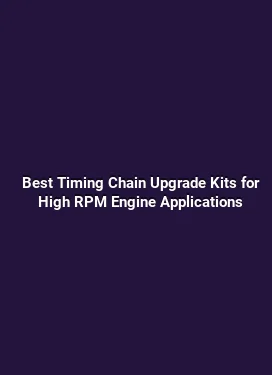Engine Blueprinting Guide: How to Build Perfect Tolerances for Racing
Foundations of Blueprinting: What It Means to Prepare an Engine for Competition

Blueprinting an engine goes beyond following factory specifications. It is a meticulous process of transforming every component to a shared, controlled standard that minimizes variation. The goal is consistency under race conditions: repeatable combustion, predictable oil and coolant flow, and minimal friction losses. This begins with a carefully selected block and rotating assembly, followed by precise measurements and machining, all paired with a tuning strategy designed to exploit the enhanced tolerances. A well-executed blueprint yields reliable power delivery, improved throttle response, and reduced wear over long stints on the track.
In practice, blueprinting combines mechanical discipline with data-driven tuning. It requires a clean workspace, calibrated measurement tools, and a plan that connects every decision—from piston-to-wall clearance to camshaft profile—to the engine’s intended operating envelope. A cornerstone of this discipline is establishing target tolerances that account for fuel, ignition strategy, cooling efficiency, and the expected RPM range. While a street engine prioritizes durability and efficiency, a race engine embraces tighter tolerances and higher thermal loads, always balanced against reliability and cost considerations.
Material and Component Selection: Laying the Groundwork for Precision
Choice of materials directly influences achievable tolerances. High-strength castings, forged pistons, and billet cranks provide uniformity and reduced dimensional drift under heat. The surface finish of bores and bearings affects oil retention and friction. For example, honing patterns that optimize oil retention without sacrificing ring seal can significantly impact late-race stability. In racing builds, many teams adopt a short-block or long-block approach where the rotating assembly is engineered for balanced clearance across all cylinders, ensuring minimal variation between pairs of cylinders.
When selecting components, it is essential to align the specification with the engine’s operating strategy. A turbocharged race engine benefits from tighter oil clearances at elevated temperatures, while naturally aspirated designs may tolerate slightly different tolerances due to distinct combustion phasing. The goal is to create a baseline that ensures consistent piston-ring behavior, piston-to-bore alignment, and bearing load distribution across the RPM and boost spectrum. This alignment supports stable compression, reduced blow-by, and predictable oil pressure across the working range.
Precision Machining and Measurement Techniques: Turning Theory into Reality
Blueprinting hinges on precision, and that begins with accurate measurement. A well-equipped workshop uses bore gauges, micrometers, dial indicators, and a cleanroom-like environment to minimize contamination. Cylinder bore straightness, finish, and bore diameter are measured to tight tolerances, followed by honing to achieve the intended crosshatch angle and surface roughness. Each component—piston, ring package, wrist pin, and bearing—receives verification against manufacturer specifications, and any deviation triggers deliberate decision-making: replace, resize, or re-machine.
Clearances are not uniform across the engine. Each bank, each cylinder can present subtle differences due to core shift, machining marks, or assembly tolerances. Blueprinting accounts for these variations by setting target end gaps, ring gaps, and bearing oil clearances that deliver consistent sealing and oiling under race conditions. The result is a rotation that feels immediate and a combustion chamber that behaves predictably across hot and cold starts.
Cylinder Bore and Piston Clearance: Balancing Sealing Power and Friction

Achieving the right piston-to-bore clearance is a balancing act. Too little clearance starves rings of the space they need to expand with heat, leading to sticky oil control and blown compression. Too much clearance invites excessive ring land wobble, reduced ring seal, and elevated oil consumption. The real-world target varies with engine design and operating temperature, but modern race-builds often employ a bore clearance window measured in thousandths of an inch that is validated during dyno testing across multiple loads and RPM ranges. A practical approach is to establish a baseline clearance, then validate it with controlled heat cycles and oil pressure readings to confirm stable ring seal and minimum oil blow-by at peak power.
Ring End Gap and Ring Type: From Static Fit to Dynamic Performance
Rings must seal reliably as piston rings cross the top of the bore under different temperatures. End gap sizing is critical because the gap expands as the engine heats. In a high-performance build, technicians may adapt end gaps separately for top and second rings to ensure robust sealing while managing oil control. The decision is influenced by ring material, coating, and the engine’s intended load profile. During blueprinting, measuring end gaps at a precise temperature and validating with heat-soaked cycles helps prevent late-race oil consumption and combustion chamber deposits that can erode power output.
Valve Train and Camshaft Strategy: Synchronizing Timing with Tolerances
The valve train translates the rotating motion into controlled air and fuel flow. Blueprinting a race engine requires harmonizing camshaft timing with the actual physical clearances found in lifters, pushrods, and rocker arms. Small shifts in deck height, valve stem diameter, or lifter bore alignment can alter valve lash and ultimately change intake and exhaust timing. The result is a shift in torque delivery and a change in volumetric efficiency as engine speed climbs.
Many teams adopt adjustable cam timing strategies or serve up cam phasing maps that respond to RPM and temperature. The practical effect is maintaining optimal overlap and lift at critical RPM bands where the engine generates peak power. This approach demands precise measurement of valve timing during assembly and meticulous validation on a dyno to ensure no unintended valvetrain bounce or pre-load changes at high RPMs.
Preload, Lash, and Bearing Clearance in the Cam Chain/Sprocket Area
Cam chain tension and sprocket alignment influence valve timing stability. Blueprinting this area involves confirming chain tension across the operating range and verifying that the camshaft sprockets maintain precise alignment with minimal axial play. Even small deviations can drift timing when the engine is thermally loaded. By controlling preloads and measuring bearing clearance in the cam chain area, teams reduce timing drift and improve durability under sustained racing conditions.
Fuel and Ignition Mapping: Translating Mechanical Precision into Power
With tighter tolerances in place, the engine’s electronic management system must extract the maximum performance without compromising reliability. Fuel and ignition maps are the bridge between mechanical precision and controllable power output. The calibration process involves fueling strategies that respect the improved sealing and reduced friction, enabling a cleaner, more stable air-fuel mixture across the RPM range. Ignition timing can be advanced or retarded according to data from sensors, exhaust temperature, and knock detection, culminating in a map that keeps peak torque within the engine’s safe envelope.
During tuning, many teams emphasize data logging and traceability. Continuous measurements of knock intensity, exhaust gas temperature, turbine or compressor boost, and air mass flow inform incremental map refinements. The objective is to maintain consistent air/fuel ratios and stable ignition across shifts in load, boost, and temperature, ensuring the engine delivers predictable response from the first turn of the key to the final lap.
Boost Control and Fuel System Integration
In forced induction setups, boost control becomes a primary determinant of power delivery. The blueprinting process ensures the hardware can sustain exact boost pressure over the target RPM band without spiking or lagging. This requires not only a properly sized wastegate or bypass system but also a robust feed system capable of delivering consistent fuel flow at high demand. The integration of the fuel pump, lines, regulators, and injectors with the engine management strategy ensures the engine remains within safe operating limits as boost evolves with throttle and altitude changes.
Thermal Management and Lubrication: Keeping Tolerances Stable Under Stress
High-performance engines face extreme thermal loads that threaten tolerance stability. Effective cooling strategies keep jacket temperatures uniform, preventing hot spots that distort clearances and oil viscosity. Blueprinting must consider cooling channel reliability, thermostat behavior, and radiator capacity to maintain consistent operating temperatures. A well-tuned oil system also supports tolerance stability by maintaining proper oil pressure and film thickness across RPM and load. Oil viscosity, temperature compensation, and scavenging efficiency all contribute to maintaining the intended clearances during a race and reducing wear over time.
During testing, teams monitor oil temperature, pressure curves, and bearing wear indicators to verify that lubrication remains sufficient as the engine cycles through demanding conditions. Any drift in oil pressure or pressure drop signals potential changes needed in tolerances, lubrication strategy, or cooler performance to preserve engine integrity during a race.
Dyno Validation and Track Correlation: From Bench to Barracks
A successful blueprint is validated on a dynamometer, where controlled heat, airflow, and load profiles mimic real-world track conditions. The process includes cold and hot pulls, reproducibility checks across multiple cylinders, and stress testing at peak RPM and temperature. The insights gained here guide final adjustments to clearances, cam timing, and fuel maps. The correlation with on-track data completes the loop: what works on the dyno should translate to predictable performance under race-day stress, including roll-on acceleration, corner exit power, and sustained high-RPM operation.
Track correlation requires careful data interpretation. Variances in acceleration, traction, or cornering dynamics can reveal subtle differences in tolerances that are not obvious on the dyno. Teams leverage telemetry data to refine both mechanical tolerances and the corresponding driving strategies, ensuring the engine behaves consistently across different tracks and weather conditions.
Data-Driven Iteration: Turning Numbers into Gains
The most effective blueprinting programs use iterative cycles of measurement, analysis, and adjustment. Each iteration tests a new tolerance target or a revised map in a controlled manner. The iterative approach reduces risk by isolating the effect of a single change and validating it across multiple operating points. In practice, this means documenting every measurement, every torque value, and every temperature while progressively tightening tolerances and refining the control strategy until the desired repeatability and power are achieved.
Practical Tips for Teams Undertaking a Blueprinting Project
Begin with a clear objective: power, reliability, or a specific RPM range. Document current baseline tolerances and identify critical failure modes such as oil bleed, piston slap, or valve train instability. Build a test plan that includes short-run dyno sessions, heat soak cycles, and track simulations. Use precision tools and calibration standards to reduce measurement drift, and maintain a clean environment to protect critical surfaces during assembly.
Coordinate mechanical work with calibration steps. After each machining or assembly milestone, re-check key gaps and clearances to confirm that the target windows remain within specification. Ensure the management strategy is aligned with the engine’s physical state, and always validate new settings under both steady-state and transient load conditions. By combining disciplined mechanical work with rigorous mapping, the engine becomes a predictable performance platform rather than a gamble on race day.
Risk Management: Balancing Tight Tolerances with Durability
Extreme tolerances can yield higher peak power but also raise the risk of failure due to thermal runaway or unexpected loading. It is crucial to identify critical stress points and implement safety margins in both hardware and calibration. Setting conservative thresholds for knock, oil temperature rise, and boost spikes provides a buffer that protects the engine without compromising the performance gains achieved through blueprinting.
Conclusion: Harnessing Precision for Consistent Race Performance
Blueprinting an engine for racing is a discipline that weaves mechanical engineering with calibrated control strategies. By focusing on bore and piston clearance, ring end gaps, valve train alignment, and a coherent fuel-ignition map, teams create a platform that delivers consistent power, predictable response, and durable operation under demanding race conditions. The process thrives on meticulous measurement, controlled machining, and rigorous validation, paired with a data-informed tuning approach that respects the engine’s unique architecture and intended competition environment.






